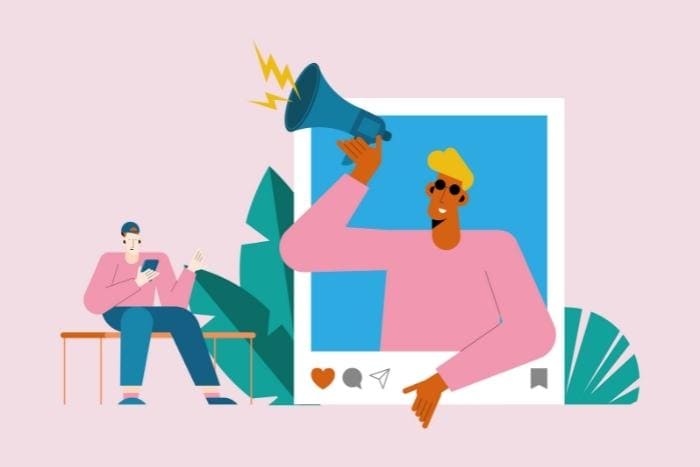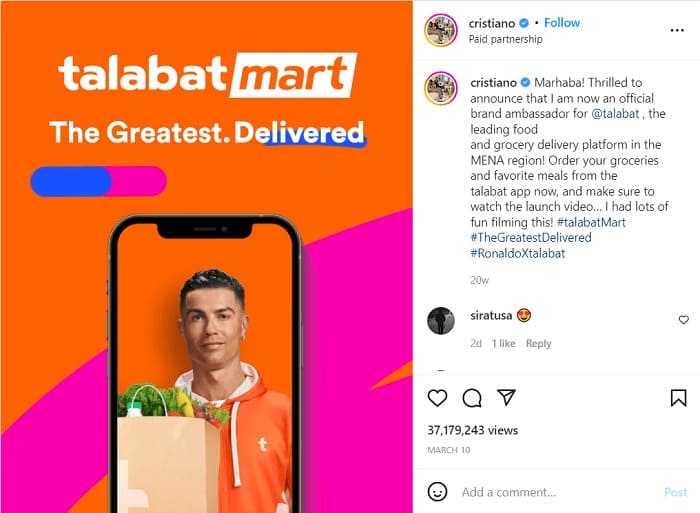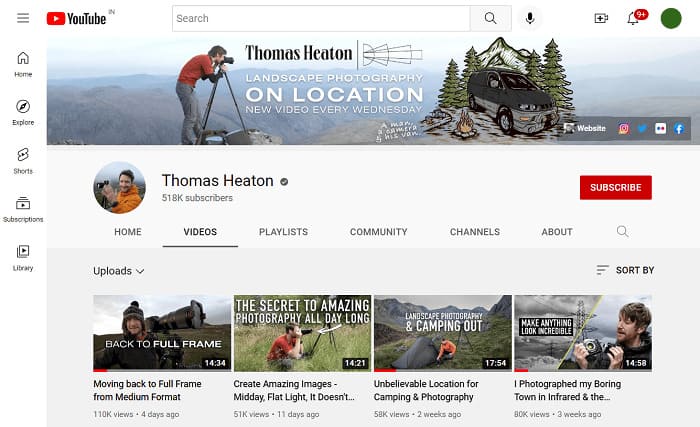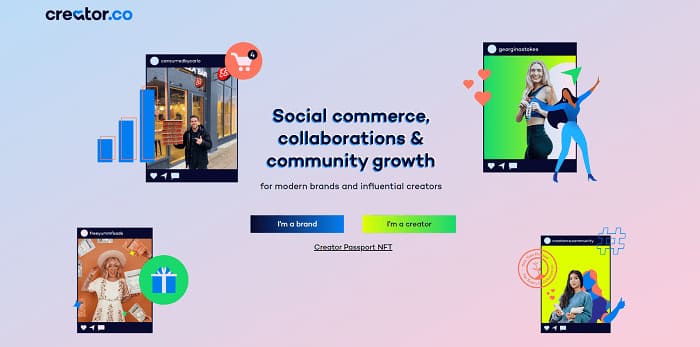A social media influencer can amplify your reach and improve engagement, all without burning a hole in your pocket.
Yet, it’s challenging to find the right influencer for your brand.
This post will get you up to speed on this and more. We’ll introduce:
- five types of social media influencers
- discuss the pros and cons of each
- give you some questions to help choose the best influencer for your brand.
Sounds good?
Let’s dive right in.

What is a Social Media Influencer?
Most people are active on social media and have gathered a following, but that doesn’t make you an influencer.
A social media influencer is someone who has:
- established credibility in a niche
- has created a passionate audience
- considerable influence over their followers
A social media influencer’s power comes from their ability to establish an authentic relationship with their followers. In turn, it helps them drive massive engagement on the platform.
Why are Influencers Important to Your Brand?
Social media influencers can convert indecisive buyers to paid customers through the power of word-of-mouth.
How?
As stated above, they have established an authentic relationship with their followers.
In fact, 63% of 18-34-year-olds trust social media influencers more than brands.
So, a simple recommendation from someone you admire or trust implicitly can convert you into a customer.
Also, a social media influencer can amplify your brand’s reach and influence at a fraction of the cost and effort it would take you through conventional means.
Furthermore, influencer marketing is estimated to generate 11x higher ROI than digital media and a ~6x higher return compared to paid media.
5 Types of Social Media Influencers That Will Empower Your Brand
Not every social media influencer has the same impact. Some can boost brand awareness while others focus on engagement.
So, while there are several ways in which you can categorize them, let’s look at a ‘beginner-friendly’ manner of segregating them.
1. The Mega Influencer
These are people with a million+ followers. Some of these are celebrities in the offline world — think actors, singers, sportspersons, etc.
But others are regular people that have built a massive following.
For example, check out Cristiano Ronaldo on Instagram. With 471 million+ followers, a single post from him can garner millions of views in mere seconds.

This sponsored post for ‘talabatMart’ (leading food and grocery delivery platform in the Middle East and North Africa) has garnered 37 million+ views.
Advantages
One mega influencer is enough to boost your brand awareness, strengthen credibility in your niche and drive sales.
You won’t need to employ more social influencers as a mega influencer can cut through the clutter and give your brand massive exposure with a single post.
Disadvantages
Mega influencers are extremely expensive — Cristiano reportedly charges up to $1.6 million to endorse a post on social media.
Also, while this approach can guarantee you a wide reach, it’s not effective at driving meaningful engagement.
Why?
Because it’s difficult to target a specific niche or audience given how diverse their followers are.
2. The Macro Influencer
Anyone having 100k to a million followers is a macro influencer. They are consistent content creators — bloggers, vloggers, podcasters, and the like.
Most of these are strong affiliate marketers. Over time, they have established their expertise in a specific niche and hold a powerful sway over their audience.

Consider Thomas Heaton, who has become the go-to guy for landscape photography.
Through his Youtube channel, he educates his 518k+ audience about shooting awesome outdoor pictures. He is also able to subtly weave in affiliate recommendations in his content.
Advantages
Macro influencers are experts in crafting highly engaging content. If your product adds value and is the right fit for their audience, they would be more than willing to establish a long-term relationship with you.
A few such strategic collaborations can do wonders for your brand engagement and roping in steady sales.
Disadvantages
Beware of potential fraudsters! Some of these ‘influencers’ have attained fake followers by (literally) purchasing them instead of earning them the hard way.
Besides, these influencers are still expensive due to their larger followings and might come across as inflexible in their approach to working with you.
3. The Micro Influencer
A micro influencer is anyone that has between 1k-100k followers. Most have worked diligently to establish themselves as a credible source of information in their target niche.
For example, Char is an Instagram influencer that has built a following of 31.9k followers talking about curls, fashion, beauty & lifestyle.

She often runs sponsored posts like the one above for Spotify, which created high engagement within her community — garnering 1197 likes and 57 comments.
Advantages
The tightly-knit community of these social media influencers ensures active participation. This can lead to high conversions if your brand values resonate with the influencer’s audience.
Disadvantages
Micro influencers can be picky about which brands or products they work with as their communities are loosely bound by common interests.
If they deviate from these interests, their audience wouldn’t think twice about hitting the unfollow button and moving on to another influencer.
For example, if Char (“the curly hair enthusiast” – above) suddenly promoted hair straighteners, her audience would jump ship and follow another curly hair inspired influencer.
4. The Nano Influencer
A nano influencer is someone who has up to 10,000 followers. But don’t get misled by the (relatively) small size. These social media influencers can have very high engagements as they cater to specialized segments and niches.
Look at Lewis, who is a lifestyle Instagram influencer.

He has collaborated with high-end brands such as Oliver Peoples sunglasses and men’s clothing brands like Sprezz. In 2019, he co-founded bespoke menswear brand Charles Paige Atelier.
His posts regularly attract 200+ likes and comments from his followers. The degree of engagement is evident from the quality of the comments on the posts.
Advantages
If your product caters to a very specific niche, then nano influencers are for you.
Not only will they generate tremendous excitement for your product, but they have the most engaged audience compared to other influencer types.
On top of that, they are relatively inexpensive. Some may even promote your brand in exchange for a free product.
Disadvantages
But if your product is part of a larger niche, it would require a greater reach to make a dent in the market.
In this case, you would have to work with several nano influencers simultaneously, which can be challenging to manage.
5. The Employee Influencer
Employees are the perfect social media influencer.
Why?
Because they know the brand inside out!
Their ability to add a personal experience can make the brand relatable to consumers as opposed to the “professional” influencers.
Check this post from Sahil Khanna.

He frequently posts about the wonderful work that Sun King (his employer) does in providing off-grid solar products to people living in areas with unreliable energy access.
Note how the personal narrative and the informal pic make the brand Sun King much more attractive and appealing to the readers.
Advantages
First and foremost, leveraging employee influencers in your company is a simple, cost-effective way to expand your reach and increase conversions.
After all, they already work for you.
Secondly, an employee influencer is a face behind the brand. Someone consumers can trust, and who provides authentic content that resonates with your audience.
Disadvantages
With so many social platforms and millions of accounts, it’s difficult for companies to control content from employee influencers.
It’s not an issue with a happy employee, but what about a disgruntled one?
It’s easy for an unhappy employee to start spreading negative or false information about a company — whether warranted or not.
5 Key Questions to Help You Find the Right Influencer For Your Brand
Ready to tap into the influencer marketing industry?
Let’s get you started by answering a few fundamental questions to help you identify the right social media influencer for your brand.

1. What Are Your Social Media Marketing Goals?
In other words, what do you want to achieve from your influencer marketing? Do you want to:
- increase your brand awareness?
- drive traffic to your website?
- generate leads?
- boost product sales?
- improve community engagement?
- attract talent to join your organization?
This is critical because, as we discussed earlier, not all social media influencers are equal. For instance, a mega influencer will drastically increase brand awareness, whereas a nano influencer will improve community engagement.
2. What’s Your Target Audience?
Your target audience is your ideal customer. Someone for whom your product is a perfect fit.
Once you know your ideal customer, find social media influencers whose followers overlap with your target audience.
Remember, it’s the influencer’s followers that you’re really interested in. The influencer is simply the ‘vehicle,’ enabling you to reach out to them faster and more efficiently.
3. Which Social Media Platform?
Knowing your perfect customer’s likes, dislikes, and interests is not enough.
You also need to know which digital platform they spend most of their time on.
And yes, social media is much more than just Facebook and Instagram. There’s Twitter, LinkedIn, Pinterest, Twitch, Youtube, Reddit, Quora, Snapchat, Tiktok etc.
Furthermore, each of these platforms has its own content framework.
Essentially, how you reach your audience on one platform, may not be how you reach them on another.
For example, if your target audience exists on LinkedIn, you wouldn’t hire a TikTok influencer.
Can you imagine a TikTok challenge on Linkedin?
4. What’s Your Budget?
Knowing your budget is critical because it will determine the types of social media influencers you have access to.
For example, you may be a large brand with a massive marketing budget, looking to increase your brand awareness. In this case, incorporating mega influencers into your marketing mix can yield good results.
Or, if your objective is to get sustained trials for your SaaS product on a limited budget, then collaborating with a few macro influencers might be better for you.
Maybe you offer a premium lifestyle product and have a shoestring budget. If so, working with micro or nano influencers might be more up your alley.
5. How Do You Find a Social Media Influencer?
Finding a social influencer is easy. Finding the one that is right for you is tricky… but not impossible.
Your target audience will help you identify a few platforms that your customers frequent.
Shortlist a few social media influencers on those platforms and analyze which of them will be able to best meet your goals. Reach out to the chosen few, propose a collaboration, and off you go.
Alternatively, you could use an influencer marketplace tool like creator.co.

It hosts a database of 500 million+ macro and micro-influencers that you can manually search through to find the ones that fit your brand.
Or, you can take it a step further and automate your search by defining your influencer campaign. Creator.co algorithms then match the social media influencers to your requirements, leaving you to pick and reach out to your chosen social influencers.
How To Make Social Media Influencer Marketing Work For You?
Social media influencer marketing is the same old “traditional” marketing with a digital twist. The principles remain the same – only the medium changes.
Numerous tools and platforms are available that have simplified the entire process. You only have to log in, create, run, and stop the campaigns.
So what will you do?
Will you make an excuse? Or will you start using influencers in your social media marketing strategy today for much bigger gains tomorrow?
Let me know in the comments below.



